Fermenting Beer with White Labs WLP590 French Saison Ale Yeast
Published: September 29, 2025 at 8:55:23 PM UTC
Last updated: October 9, 2025 at 7:11:20 PM UTC
White Labs WLP590 French Saison Ale Yeast is a top pick for brewers aiming to create dry, spicy farmhouse ales. It's available under part number WLP590, in both core and organic versions. The yeast boasts an attenuation range of 78–85%, medium flocculation, and a high alcohol tolerance. This makes it ideal for both standard and high-ABV saisons.
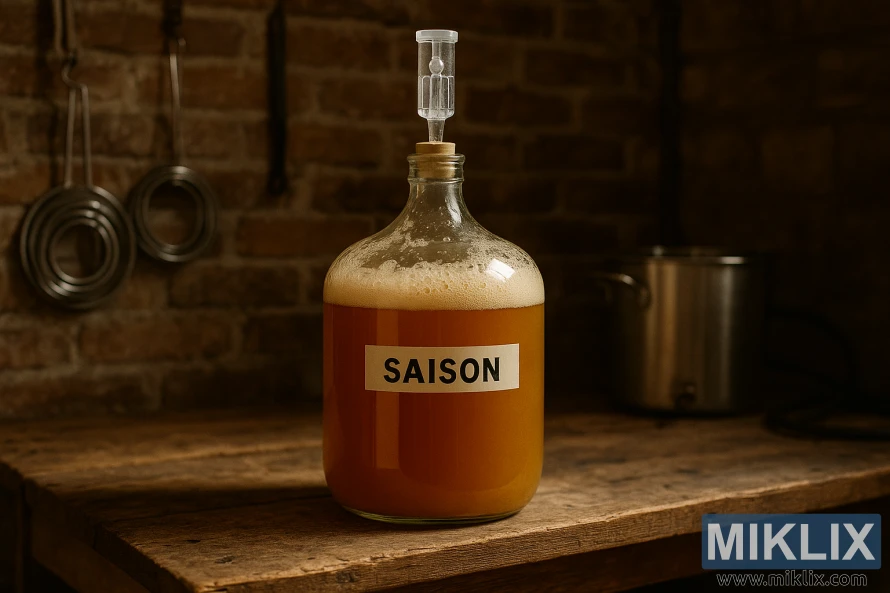
Fermenting with WLP590 results in lively fermentation and distinct phenolics. Homebrewers have reported rapid krausen formation within the first day and very dry finishes. Flavors often include pear, mandarin, cracked pepper, and light banana. The yeast is POF+ and STA1 positive, which can impact fermentability and conditioning times.
Temperature flexibility is a significant advantage. The recommended range is 68°–85°F (20°–30°C). Beer-Analytics suggests an optimal temperature range of 69.8–75.2°F. Brewers often pitch conservatively and allow a controlled temperature rise. This helps to enhance spice and fruit flavors without introducing solvent notes.
Key Takeaways
- WLP590 is marketed as White Labs WLP590 French Saison Ale Yeast with high attenuation and medium flocculation.
- Fermenting WLP590 typically produces peppery phenolics and fruity esters with a very dry finish.
- The strain is STA1 positive; exercise caution with bottle conditioning and mixed fermentations.
- Ideal fermentation sits in the 68°–85°F range, with many brewers preferring a moderate 70°–75°F ramp.
- WLP590 review notes often compare it to Wyeast 3711 for its aggressive, clean attenuation in farmhouse ales.
Overview of White Labs WLP590 French Saison Ale Yeast
WLP590 is White Labs' core French saison ale yeast, known for its bright, dry finish and spicy fruit notes. It's a favorite among brewers for saisons, farmhouse ales, and witbiers. They seek lively pear, apple, and cracked pepper aromas.
Technical specs for WLP590 include high attenuation, medium flocculation, and very high alcohol tolerance. White Labs reports attenuation between 78%–85% with a fermentation range of 68°–85°F (20°–30°C). Beer-Analytics notes the liquid form and an average attenuation near 81% for practical batches.
Practical brewing notes highlight aggressive fermentation and a clean yet expressive profile. Homebrewers compare WLP590 to Wyeast 3711 for speed and dryness, while maintaining a distinct French character. The STA1 QC result for this strain is positive, leading to strong saccharification and very dry finishes.
- Typical uses: French-style saisons, farmhouse ales, Belgian witbiers.
- Key traits: pear and apple esters, peppery phenolics, very dry attenuation.
- Handling tips: pitch healthy yeast, monitor temperature, expect active fermentation.
This WLP590 overview aids brewers in aligning yeast choice with recipe goals. Reviewing White Labs saison yeast behavior and WLP590 specs before brewing minimizes surprises. It supports consistent results in saison and farmhouse beers.
Flavor and Aroma Profile of WLP590
White Labs WLP590 is perfect for French-style farmhouse ales, with a clear saison yeast aroma. Tasting notes often mention pear and apple esters that are light on the nose. Brewers also report a strong cracked pepper character, adding a spicy backbone to lighter malt bills.
The WLP590 flavor on the palate features mild fruit esters and spicy phenolics. Some batches may have a faint banana or bubblegum touch, but these notes are secondary to the peppery and citrusy elements. The balance ensures beers are crisp and drinkable, while maintaining farmhouse complexity.
House and homebrew tasting notes for saisons fermented with WLP590 include mandarin and black pepper aromas. A small warming alcohol note can appear in younger beer, usually subsiding after conditioning. Glycerol production adds to a fuller mouthfeel, despite a dry finish.
Brewers aiming for a classic French farmhouse character can rely on the pear apple cracked pepper yeast impressions. Adjust malt sweetness and hopping to let the saison yeast aroma and WLP590 flavor stand out. This way, delicate esters and spicy phenolics are not masked.
Fermentation Performance and Attenuation
WLP590 offers a robust fermentation performance, with attenuation ranging from 78% to 85%. This range results in very dry finishes, ideal for classic farmhouse and saison styles. Brewers often aim for this level of dryness.
Lab data and brewer feedback align on an average attenuation of 81.0%. This confirms WLP590's reputation for high attenuation. Expect medium flocculation, leaving some yeast in suspension but clarifying over time.
Case studies highlight rapid fermentation onset. In one instance, fermentation began visibly around 12 hours. By roughly 21 hours, a pronounced krausen formed. The yeast efficiently consumed added dextrose, reaching a final gravity near 1.002 and producing about 6.8% ABV.
Brewers aiming to shape ester and phenolic profiles often pitch on the lean side. They allow temperatures to rise during active fermentation. This method leverages the yeast's vigorous nature to drive dryness while controlling aromatic intensity.
- Attenuation: generally 78%–85% with common reports around 81.0%.
- Fermentation speed: fast onset and strong krausen within a day.
- Practical tip: low pitch plus temperature rise helps manage esters and phenolics.
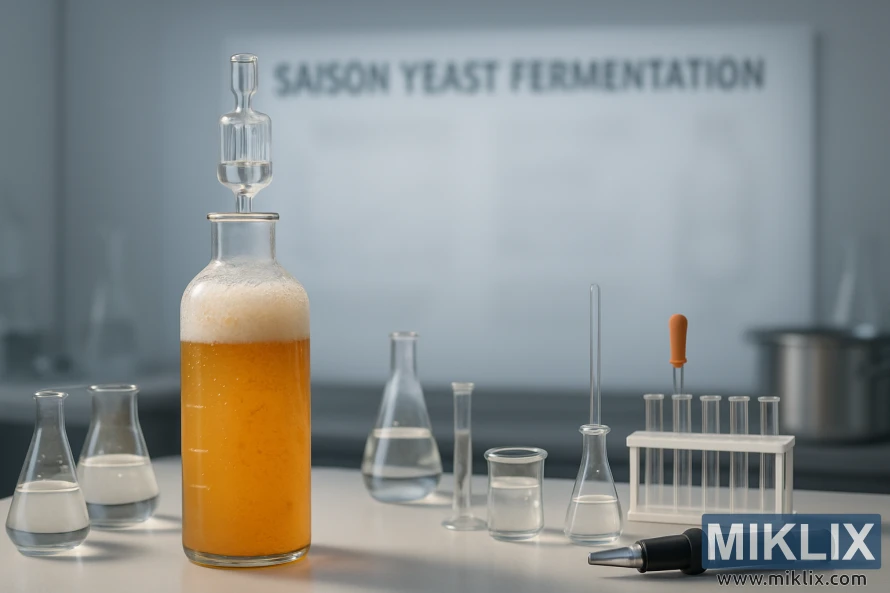
Temperature Range and Fermentation Control
White Labs suggests a wide temperature range for WLP590, from 68°–85°F (20°–30°C). This range highlights the strain's adaptability for rustic farmhouse ales. The upper end of this range enhances phenolic and peppery flavors, while the lower end keeps esters in check.
Beer-Analytics recommends a more specific temperature range for fermenting saisons, around 21–24°C (69.8–75.2°F). Staying within this range helps preserve fruit flavors without introducing solvent-like compounds. Many professional brewers consider this range ideal for achieving balance and drinkability.
A practical approach involves pitching at 23°C and then gradually increasing the temperature. Start at 20°C, then slowly raise it to 22°C, 24°C, and 26°C over several days. This method promotes a vigorous start and a clean finish. It also helps avoid sulfur or fusel production by gradually increasing the temperature.
Controlling the temperature during both fermentation and conditioning is critical for WLP590. Utilize a fermentation chamber or jacket to manage temperature fluctuations. Monitor gravity and aroma as you adjust temperatures to guide the yeast towards the desired profile.
- Start: pitch near 20–23°C to ensure a healthy lag phase and predictable start.
- Mid-ferment: raise slowly in 1–2°C steps to accentuate spice and pepper character.
- Finish: hold warm briefly to reach terminal gravity, then crash cool for conditioning.
Gradually increasing the fermenting saison temperature often enhances the beer's character while minimizing off-flavors. Once fermentation approaches terminal gravity, crash cooling and conditioning help stabilize flavors and clarify the beer. Keep track of temperatures, taste regularly, and adjust the temperature control for WLP590 to align with your style goals.
Alcohol Tolerance and High-ABV Saisons
White Labs rates WLP590 alcohol tolerance as Very High (15%+). This makes it an ideal choice for crafting big saisons and doubles. The strain's ability to thrive in high-alcohol environments sets it apart from many ale yeasts that falter under such conditions.
For precise information, refer to the laboratory sheets and packaging of any vial or culture. Beer-Analytics suggests a more conservative alcohol tolerance. Real-world attenuation data, on the other hand, provides a clearer picture of what happens during fermentation.
Practical brewers have successfully pushed WLP590 to robust alcohol levels. A documented farmhouse batch achieved an ABV of roughly 6.8% with a final gravity near 1.002. Some tasters noted a hot alcohol edge at higher strengths, which mellowed with weeks of conditioning.
STA1 positivity is key to extended attenuation. The yeast's diastaticus high alcohol capability allows it to break down complex sugars. This enables deeper attenuation and higher ABV, even with adjuncts or long-mash techniques that increase fermentable dextrins.
- Check lab specs and lot information before planning a high-gravity brew.
- Use healthy pitching rates and oxygenation to support fermentation at elevated gravity.
- Plan extra conditioning time to let fusel alcohols and solvent notes mellow.
Flocculation, Clarity, and Conditioning
White Labs categorizes WLP590 as a medium flocculation strain. Beer-Analytics also notes this characteristic. This means the yeast cells settle at a moderate pace. As a result, a beer fermented with WLP590 might retain some haze after fermentation.
To achieve a clearer beer, several practical steps can be taken. Cold-crashing the beer to near 5°C helps more yeast settle out. Adding a fining agent like Biofine Clear after this process can further enhance clarity. This method preserves the delicate flavors of a saison without stripping them away.
A case study demonstrated the effectiveness of this approach. A beer with an orange haze after primary fermentation was clarified significantly. It was cooled to 5°C and Biofine Clear was added. Further conditioning at 1°C before kegging led to even better clarity and stability.
If you aim for a polished appearance, consider conditioning WLP590. Cold-conditioning the beer helps firm the yeast cake and reduces chill haze. Conditioning WLP590 at fridge temperatures for several days to weeks can result in a clearer final product.
- Expect moderate settling with WLP590 flocculation.
- For clearing saison yeast, combine cold crash and a clarifier.
- Conditioning WLP590 at low temperatures improves stability and brightness.
Remember, WLP590's high attenuation can lead to very low final gravities. After conditioning and proper fining, many brewers achieve stable clarity. The beer retains its characteristic dry, peppery, and fruity flavors typical of saisons.
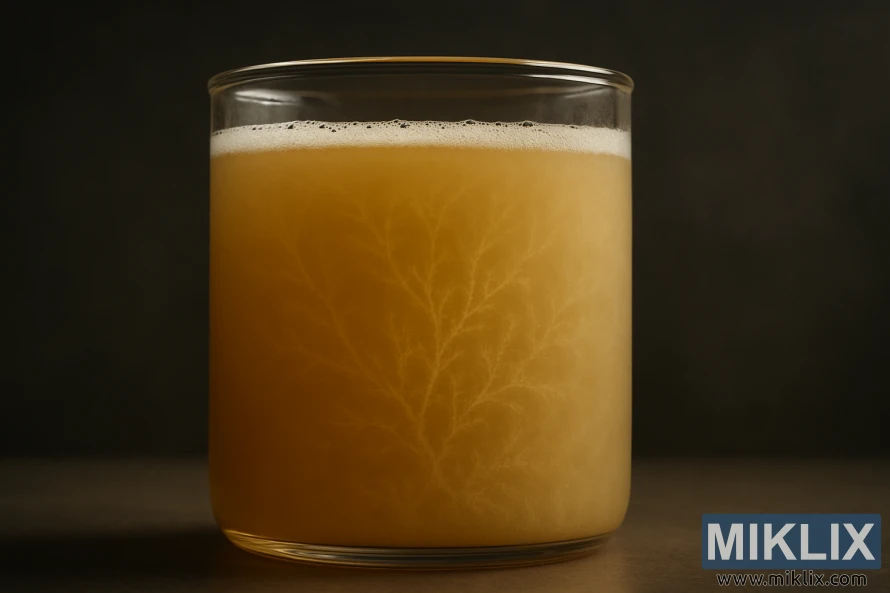
STA1 Positivity and Diastaticus Considerations
White Labs reports WLP590 STA1 positive, indicating glucoamylase activity. This enzyme can convert dextrins into fermentable sugars. Brewers should consider this when aiming for specific final gravities.
Independent testing and a Beer-Analytics profile reveal mixed results. The safest approach for recipe planning and cellar management is to cross-check White Labs' QC result.
As a diastaticus yeast, WLP590 can ferment sugars that many common strains miss. This trait increases the risk of over-attenuation if there are extra simple sugars during conditioning.
Real-world brewers confirm WLP590's diastaticus behavior and POF+ status. This combination can lead to very low terminal gravities when dextrose or other simple sugars are added.
Handling a WLP590 STA1 positive strain requires careful steps. Controlling priming sugar, considering pasteurization for packaged beer, and dedicating equipment are essential.
- Monitor gravity closely during conditioning.
- Avoid unintentional sugar additions when packaging.
- Isolate yeast sources to prevent cross-infection.
By taking these precautions, brewers can harness the starch degrading yeast characteristics for desired dryness. This reduces the risk of unwanted secondary fermentation.
Pitching Rates and Yeast Health
Accurate WLP590 pitching rates are key to preventing slow starts and unwanted flavors. White Labs offers a pitch rate calculator. It aligns cell counts with batch size and original gravity. This is essential for planning saisons, even more so for high-OG recipes.
Many brewers opt for a yeast starter WLP590 for liquid culture. A small starter increases cell numbers and shortens lag time. For beers over 1.070, a starter or multiple vials are necessary for consistent results, surpassing what a single pouch can offer.
Yeast vitality in saisons depends on proper oxygenation and temperature control at pitch. Ensure the wort is well-aerated before adding yeast. Aim for pitching temperatures that are optimal for the strain. Healthy cells ferment more efficiently, reaching final gravity quicker.
- When to use a starter: worts over 1.060, large batches, or when reuse of harvested yeast is planned.
- For lower-gravity saisons, one fresh pouch often suffices, provided you oxygenate adequately.
- Consider making a step-up starter for very high ABV saisons to build robust cell counts.
Case studies indicate that while one-pouch pitches can succeed, variability increases without a vitality starter. Regularly check cell viability with a microscope or a simple methylene blue test when precision is critical. Fresh yeast from White Labs and careful handling are essential for maintaining performance.
Final practices to protect yeast vitality in saisons include rehydrating when necessary, avoiding excessive heat shock, and pitching at the recommended WLP590 rate. These steps help reduce stress on the culture. They support steady attenuation and clean flavor development.
Comparisons to Similar Saison Strains
Brewers often compare WLP590 and 3711 side by side to note subtle differences. White Labs classifies WLP590 as a French saison strain within its core lineup. This classification sets expectations for peppery phenolics, fruity esters, and a very dry finish.
Field notes from Beer-Analytics place WLP590 in the French-style saison category, matching typical saison yeast comparisons. In practice, WLP590 ferments fast and cleans up well at higher temperatures. This mirrors the behavior many brewers report for Wyeast 3711.
Homebrewers who track performance say WLP590 and Wyeast 3711 comparison shows overlapping traits. Both strains reach high attenuation and deliver spicy, phenolic notes with a lean body. Differences appear in ester balance; WLP590 leans slightly more toward pepper and subtle fruit in several tastings.
When stacked against more estery Belgian strains or complex blends, WLP590 keeps a simpler, drier profile. For saison yeast comparisons this matters: choose WLP590 for classic French saison character, pick blended or Belgian strains for heavier fruity esters and richer mouthfeel.
- Fermentation speed: WLP590 and 3711 are rapid producers, useful for short primary schedules.
- Flavor focus: Both give peppery spice and citrus-fruit notes; WLP590 may show a touch more pepper.
- Final dryness: High attenuation in both yields very dry finishes ideal for farmhouse ales.
For brewers deciding between WLP590 vs 3711, consider your target. If you want a straightforward French saison with crisp dryness and pepper, WLP590 fits well. If you seek slight differences in ester expression, perform a small split batch. This will allow you to observe the Wyeast 3711 comparison in your specific wort and fermentation conditions.
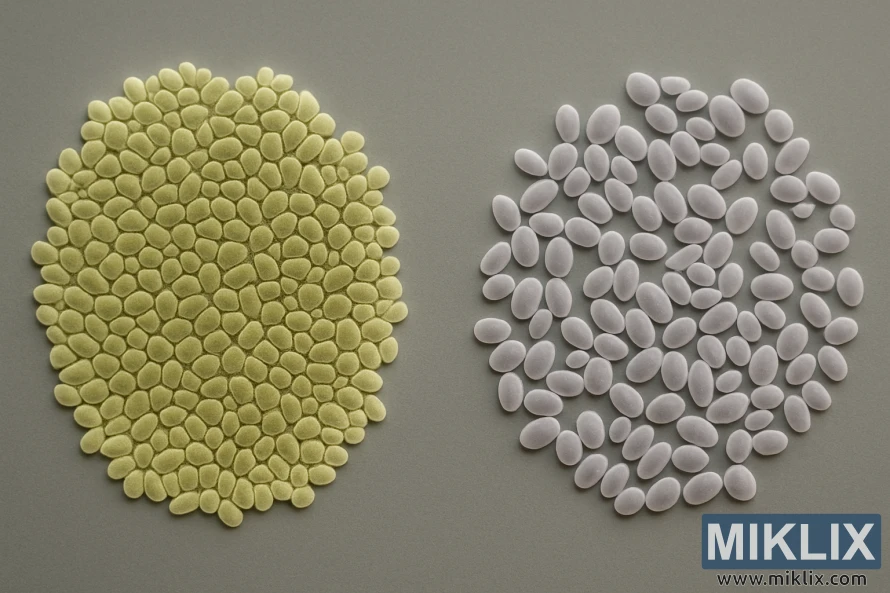
Recipe Building with WLP590 for Saison and Farmhouse Ales
Begin by setting your target attenuation and mouthfeel. WLP590 recipes excel with a moderate mash rest fermentability. For a drier saison, increase pilsner malt and add dextrose. This pushes attenuation. For more body, add Munich or flaked oats for softness.
Use this grain framework as a guide for your farmhouse ale grain bill. Aim for 50–60% Pilsner Malt, 8–12% wheat for head retention, and 6–10% Munich or Vienna for depth. Add small amounts of Caramunich or similar crystal for light caramel notes. Keep specialty malts under 10% to let yeast character shine.
- Pilsner Malt: 55% for a bright, lean backbone.
- Gladfield Ale or pale malt: 10–15% for fermentable sugars and mouthfeel.
- Wheat: 8–12% for foam and haze.
- Munich: 6–9% to add malt richness.
- Caramunich III: 2–3% as a balancing accent.
- Dextrose: 8–12% if targeting high attenuation.
Follow mash temperatures near 149–150°F (65°C) for 60 minutes to produce a balanced fermentable wort. This approach mirrors classic recipes and supports consistent attenuation with saison recipe WLP590 yeast character. Adjust mash if you need more dextrins for mouthfeel.
Hop selection should remain modest. Use regional varieties like Willamette or Wakatu for gentle spice and fruit. Consider a first-wort addition of a clean hop such as Pacific Jade for a subtle bitterness profile. Late additions at flameout will preserve aroma without overshadowing spicy phenolics from yeast.
Pitch healthy yeast at about 1.0–1.5 million cells per milliliter per degree Plato for ales when no starter is used. For richer grain bills or higher gravity batches, build a starter to maintain fermentation vigor. Warm fermentation and a controlled ramp to the mid-70s°F encourages the peppery esters and phenolics typical of WLP590 recipes.
Adjuncts like hay, orange peel, or light spices can add farmhouse nuance when used sparingly. Add delicate adjuncts during active fermentation or in the conditioning phase to avoid harsh vegetal notes. Consider priming with a small amount of dextrose if you want a crisper finish without residual sweetness.
Water profile matters. Target moderate calcium with balanced sulfate-to-chloride ratios; for the Saint Sophie–style approach, a sulfate-forward profile emphasizes dryness, while a slightly higher chloride supports fullness. Adjust according to your farmhouse ale grain bill and desired flavor balance.
Test small pilot batches before scaling up. Record mash temps, pitch rates, and fermentation ramps. Many successful saison recipe WLP590 brewers note that subtle tweaks in grain bill and temperature timing produce dramatic changes in spice, fruitiness, and final attenuation.
Real-World Fermentation Timeline and Case Study Notes
This WLP590 case study documents a Saint Sophie Saison brewed on 8/9/2019. The wort was cooled to 23°C and aerated by splashing. The yeast was pitched at the same temperature. Activity was visible within 12 hours, with a robust krausen by 21 hours.
At around 48 hours, the fermenter's temperature was adjusted to 22°C. Dextrose in boiling water was added to bring the gravity close to 1.020. The fermentation remained vigorous, consuming the added sugar within days.
By 72 hours, the chamber's temperature was set to 24°C. Around 120 hours, the temperature was increased to 26°C to aid in finishing and attenuation. By 19/9/19, the gravity had stabilized, prompting a drop in the fermentation chamber to 5°C.
Cold conditioning continued, with the beer dropping below 5°C by 22/9/19. The brew was fined and cooled to 1°C for further clarification. Kegging occurred on 27/9/19, with a final gravity of 1.002 and an ABV around 6.8%.
Key insights from this WLP590 fermentation timeline highlight aggressive early fermentation and rapid sugar consumption. The yeast demonstrated strong attenuation, reaching terminal gravity within a week.
- Day 0: Pitch at 23°C, visible activity by 12 hours.
- Day 2: Adjust to 22°C, add dextrose in boiling water.
- Day 3: Raise to 24°C to maintain activity.
- Day 5: Raise to 26°C to ensure completion.
- Day 11–18: Crash to 5°C, fine, then cool to 1°C and keg on day 20.
Brewers following a Saison fermentation log will find this timeline invaluable for planning temperature adjustments and conditioning. Regular gravity checks and timely crash cooling ensured clarity and stability before packaging.
Common Issues and Troubleshooting with WLP590
WLP590 can produce very dry, highly attenuated saisons. Brewers who expect a fuller body may face saison yeast problems when gravity drops farther than planned. If beer finishes thin, raise mash temps to 154–158°F or include dextrin malts to retain body.
If fermentation stalls or drags, check pitch rate and yeast health before changing other variables. Underpitching, expired yeast, or poor oxygenation commonly cause sluggish starts. Rehydrate or step-pitch with a healthy starter and monitor gravity daily.
Some lab sources list medium alcohol tolerance for WLP590, so avoid assuming extreme ethanol resistance for high-OG batches. Watch fermentations in strong saisons closely and be ready to add nutrients or re-pitch a tolerant strain if attenuation falters.
STA1 positivity means diastaticus issues are possible, which can be a problem in bottle-conditioned beers. Prevent refermentation by kegging and force-carbonating, pasteurizing bottled beer, or thoroughly calculating residual fermentables before bottling.
- Too dry/over-attenuated: raise mash temp, add dextrin malts, or blend with less attenuative grain bill.
- Sluggish fermentation: increase pitch rate, oxygenate properly, use yeast nutrients, or start a starter.
- Hot alcohol or solvent notes at high ABV: allow extended conditioning; many brewers report these fade over weeks to months.
- Refermentation risk: avoid priming with residual fermentables when STA1 concerns exist; consider kettle fining and cold crash before packaging.
For phenolic or peppery off-flavors, manage fermentation temperature ramps and avoid high wort oxygen after active fermentation begins. Controlled warming can coax esters without pushing harsh phenolics.
When diagnosing, keep clear records of mash profile, pitch timing, yeast source, and temperatures. A methodical approach simplifies WLP590 troubleshooting and reduces repeat saison yeast problems in future batches.
Using WLP590 in Mixed and Brett-Influenced Ferments
White Labs markets WLP590 for farmhouse and saison styles, where mixed fermentations are common. Brewers opt for WLP590 with Brett to kick off a clean, fast primary fermentation. This is before introducing Brettanomyces or blending with barrel-aged components.
WLP590’s STA1 positivity and phenolic character make it a versatile partner in mixed fermentation saisons. As the primary yeast, WLP590 quickly reaches terminal gravity. This creates a stable base for Brett aging, without stripping all fermentable dextrins.
When planning co-fermentation WLP590 strategies, timing and attenuation are key. In a case study, beer fermented to final gravity with WLP590. Then, a portion received a bottle culture of Brettanomyces bruxellensis for separate aging. Blending after Brett maturation added complexity, while preserving the saison's structure.
Sanitation and separate equipment are critical when working with Brett. Use dedicated vessels for Brett work and maintain a strict cleaning regimen. This is to avoid cross-contamination in house cultures or mixed fermentation saison batches.
- Pitch WLP590 as the primary fermenter to secure reliable attenuation.
- Inoculate Brett later or hold a portion for Brett aging to control funk development.
- Monitor gravity and flavor over extended conditioning to track interaction between strains.
Expect extended timelines with mixed fermentation saison projects. Co-fermentation WLP590 can finish primary sugars while Brett continues slow ester and phenol evolution. This process takes months of conditioning. Adjust expectations for age, clarity, and final flavor balance.
Practical Buying, Storage, and Organic Options
White Labs identifies WLP590 as a core French saison strain. They also offer a WLP590 organic option for brewers looking for certified ingredients. When purchasing WLP590, ensure to check both regular and organic listings on product pages. This allows you to select the format that aligns with your brewing plans.
Liquid yeast comes with a freshness window. It's advisable to store saison yeast in the refrigerator. Use it before the expiration date printed on the packaging. If shipping times are extended, monitor the delivery. Store the yeast in the refrigerator upon arrival to maintain its viability.
For homebrewers, many opt to create a starter when purchasing WLP590, which is essential for higher original gravities. A starter increases cell counts and shortens the lag phase. If you're not inclined to make a starter, consider ordering extra vials or a larger quantity to ensure sufficient pitching rates.
Commercial brewers must verify the quality of the lot and STA1 status as part of their risk management strategy. Confirming the strain and any diastaticus activity helps prevent surprises in mixed fermentations and barrel programs.
- Check White Labs listings for both buy WLP590 and buy WLP590 organic options before ordering.
- Store saison yeast refrigerated; avoid temperature swings during transit and storage.
- Use a starter or multiple vials for high-OG or large-volume brews.
When older packs are available, you can create a starter to revive the yeast's vigor. Beer-Analytics suggests that the liquid form benefits from cold storage and reasonable lead times. Plan your purchases to align with your brewing schedule and avoid last-minute rushes.
Lastly, consult a pitch rate calculator when buying WLP590 to aim for the correct cell counts for your recipe. Proper pitching reduces yeast stress and supports cleaner fermentations, leading to consistent saison character.
Brewing Tips to Highlight WLP590’s Best Qualities
Begin with a straightforward, high-quality grain mix, allowing the yeast to take center stage. WLP590 excels with pale malts and a moderate mash temperature. This approach ensures a dry beer, accentuating pear, apple, and cracked pepper flavors.
Ensure a lively yeast pitch and thorough oxygenation to prevent slow fermentation. For optimal yeast management with WLP590, start with a healthy starter or fresh pack. Adhere to recommended pitching volumes based on your batch size.
- Ferment at a mid-20°C range (21–24°C) to enhance spicy phenolics and mild fruit esters, while minimizing fusels.
- Begin fermentation at the lower end of this range, then allow the temperature to rise slightly later in fermentation to enrich complexity.
- To increase body, elevate the mash temperature or incorporate dextrin malt. Blend sweetness carefully to avoid overshadowing the saison's essence.
Utilize medium flocculation to your benefit. Cold-conditioning and fining will enhance clarity without sacrificing delicate aromas. For bottle conditioning, avoid unfermented sugars that could lead to overattenuation if STA1 traits are present.
To add fermentables mid-ferment, dissolve dextrose or sugar in boiling water. Then, add it slowly to minimize foaming and oxygen uptake. This method can elevate alcohol content while preserving the beer's dry finish, which is key to maximizing saison character.
- WLP590 excels as a primary fermenter before Brettanomyces or barrel aging for additional funk.
- Monitor gravity and aroma closely; adjust temperature and oxygen levels as needed, avoiding aggressive changes.
- Keep detailed records of pitch size, temperatures, and timings for consistent results and better yeast management with WLP590 across batches.
Document your process and taste frequently. Small tweaks in fermentation profile and recipe can highlight the classic saison traits White Labs describes: pear, apple, cracked pepper, and a very dry finish.
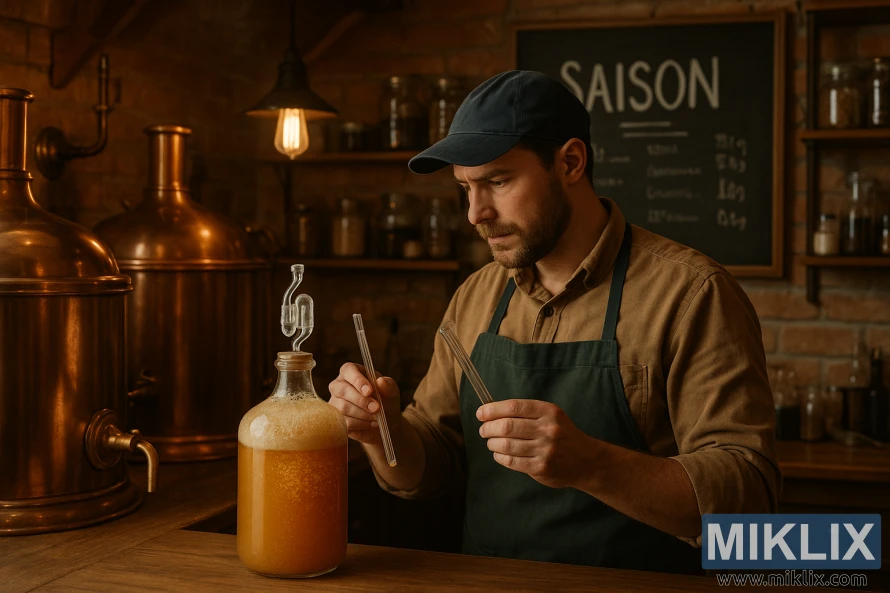
Conclusion
White Labs WLP590 stands out as a top choice for brewers aiming for high attenuation and a classic farmhouse taste. It boasts 78–85% attenuation, medium flocculation, and a broad fermentation range. This results in beers with notes of pear, apple, and cracked pepper, finishing very dry.
In real-world brewing, WLP590 offers consistent, sometimes aggressive fermentation. It works well with mixed ferments or Brett for enhanced complexity. To manage esters and phenolics, control fermentation temperature and pitching rates. Also, be aware of STA1 positivity to avoid refermentation risks during conditioning and packaging.
This review concludes that WLP590 is ideal for French-style saisons, Belgian pale ales, and biere de garde. For those looking to brew high-attenuation saisons, WLP590 is a standout. It offers dryness, spice-driven aromatics, and robust alcohol tolerance with careful handling.
Further Reading
If you enjoyed this post, you may also like these suggestions:
- Fermenting Beer with Mangrove Jack's M20 Bavarian Wheat Yeast
- Fermenting Beer with White Labs WLP351 Bavarian Weizen Ale Yeast
- Fermenting Beer with Fermentis SafLager S-189 Yeast
